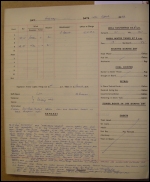Captain
GAB King was Duty Officer that day and J H Squire was watchkeeper
. According to King's entry in the ship's Log Book, Tuesday 14th
April dawned "cloudless, fine and bright" with
the wind Calm force 0, although by 8 am there was a light north
westerly (force 1-2) across the Strait, he
recorded the draft as: F 19' 10" A 21' 10', M 20' 10".[12]


Click images to enlarge
Captain Hewitt thought conditions "seemed a most favourable day for the attempted passage, fine and sunny with little or no wind"[15].
The Inquiry recorded conditions as
"clear and sunny, with a flat calm and light breeze".[4]
Captain Durrant judged the conditions
"almost ideal for the operation".[5] An encouraging
and positive start to the day.
But it was conditions outside the
Strait in the Irish Sea which had greatest effect on the tides,[TwoBdge-5]and
here the wind was north westerly force 6 increasing 7 with gusts
up to F10.[TwoBdge-7]
(The Liverpool Pilot Boat Log Book also recorded a north west
wind force 6, increasing to 7 during the morning). This was very
bad news for it would have the effect of adding significantly
to the strength of the southwest-going stream.[TwoBdge-7]
The Inquiry report observes "It is somewhat surprising to
us that the party had no knowledge of the stormy conditions prevailing
at sea at the time Conway was to make the passage. Local knowledge
may well have been that, under such circumstances, abnormal conditions
might be encountered. It seems clear, from the time 'Conway' took
to do six cables (9.23 to 10.10), that something very unusual
was taking place, possibly a strong undercurrent which is known
to occur in the channel".[4] This is an obvious
reference to the Southwest Residual (the SW-going non-tidal current
in the Menai Strait) which is known to be heavily influenced by
winds in the Irish Sea.[TwoBdge-4)] |